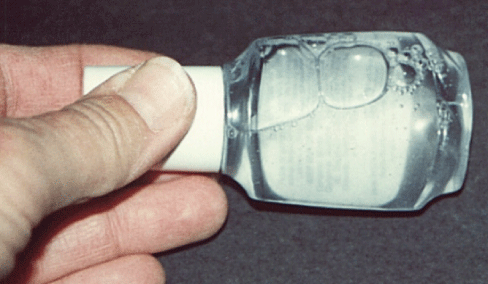GAMMA HYDROXY BUTYRATE (GHB)
GAMMA HYDROXY BUTYRATE (GHB)
Fact Sheet
WHAT IS GHB?
Gamma hydroxybutyrate (GHB) is an illicit chemical that has become a major cause of drug-related comas in the US and other countries. In fact, the number of GHB overdoses in the United States has now out-paced overdoses from MDMA (Ecstasy). GHB was rejected by the American medical community in the 1960s, but has become popular among many people for its ability to cross the blood-brain barrier freely and depress consciousness, resulting in euphoria and intoxication. It is also touted on the Internet as a sleep aid, an anti-depressant and weight loss product, although these uses are not substantiated by reality and may carry a potentially deadly twist. Starting first as an alternative to steroids in the late 1980s, when steroids were being controlled, GHB has grown into a multi-headed medical nightmare, draining emergency room services, shattering the lives of those who have lost loved ones to it, and terrifying families/friends of those addicted to it. Yet it is still a mystery to most law enforcement officers, medical/coroner personnel, and parents.
HISTORY
GHB was first synthesized in France more than 50 years ago as a possible anesthetic, but because of its undesirable side effects was rejected by the American medical community. Its legal use anywhere is dwindling as countries are beginning to recognize the problems. GHB resurfaced in 1987 as an orphan drug being researched to treat the combination of sleep disorders known as narcolepsy/cataplexy. At about the same time, steroid users were told that it might enhance the body’s production of growth hormone (in deep sleep state). However, due to growing numbers of overdoses, it was ordered off the shelves of stores in November 1990. Unfortunately, it has gained status as a recreational drug and as a rape drug, and has become dangerously common. As a result of increased restrictions on GHB itself, its “analogs,” or chemical cousins that turn into GHB in the body, have become increasingly prevalent.
USERS
• Attendees at dance clubs or “rave” parties are perhaps the most prominent users of GHB to alter mood.
• Sexual predators of all ages are attracted by the disinhibiting and euphoric effects of GHB, for they know a user may be easily taken advantage of in an assault. Some exotic dancers and strippers self-dose with GHB, seeking a “sexier” performance.
• Bodybuilders and other athletes, including professional athletes, are the least recognized users. In fact, this group, often using it on a daily basis, are the ones most likely to become addicted.
• Business professionals who travel frequently and think GHB is a safe sleep aid (comparable to melatonin, for example) are another unrecognized group, also subject to addiction and withdrawal.
• The elderly are also potential victims, being told that GHB is an anti-aging compound.
• Gay and lesbian populations also use GHB as a recreational drug. In some cases, it is also used in this community for rape or robbery purposes.
• People subject to drug testing programs use GHB as an alcohol substitute and to bypass drug testing.
NOTE: Identification of GHB is complicated by the short duration of time that it persists in body fluids and by the absence of GHB testing from the normal testing procedures of most agencies. This will hopefully change, as risks of GHB are more widely recognized.
ANALOGS OF GHB
Starting in the mid 90’s, various states added GHB to their lists of controlled substances, eventually escalating into federal legislation to control GHB. This forced gamma butyrolactone (GBL) and 1,4-butanediol (BD), to step into the spotlight. GBL is both a precursor (a primary ingredient in making GHB) and an active analog (a substance that converts to GHB in the human body, with the same physical effect as GHB). BD is an active analog, also converting rapidly to GHB in the body. Another of GHB’s many analogs that has surfaced, gamma hydroxyvalerate (GHV), fortunately did not become as popular, probably due to its lesser effects. Both GBL and BD achieve this conversion inside of the body, and GBL can transform into GHB both inside and outside of the body. GHB remains accessible to abusers through this simple conversion, though all are illegal for human consumption since March 2000, when GHB was federally scheduled. What is unsettling, though, is how easy it is to get a hold of these precursors. GBL and BD and valeric acid substances are available at gyms, chemical supply stores, the Internet, and through mail order. They are sold as powders, capsules, gels or liquids and can be found in a variety of concentrations, colors, and flavors. There are more than 90 street and trade names for GHB and its analogs.
EFFECTS OF GHB
GHB’s depressant effects on the brain in low doses produce a high or euphoric feeling as inhibitions are depressed. When the dose is increased, profound coma results. The heart rate may also be depressed or slowed. Effects on the nervous system may result in a spasm of muscle contractions called myoclonus, producing seizure-like movements. Other effects such as confusion, amnesia, vomiting and irregular breathing are dangerous when combined with the major depressant effects of GHB. Other drugs in combination with GHB, especially other depressants such as alcohol, may worsen the depressive effects and increase the possibility of a fatal outcome. The “desired” effects for GHB in low doses may sound inviting, but the consequence of the wrong dose may be death. The dosage response of GHB is quite steep, meaning that a tiny increase in dose may cause a dramatic increase in symptoms and, thus, in risk. Variable effects mean that a teaspoon might be perfect one time, but may become an overdose the next time! It is also important to be aware of the consequences that occur when GHB is mixed with other chemicals. For instance, mixing GHB with alcohol or other depressants is even more likely to result in death. The effects last about four hours and can resolve quite suddenly.
CONSEQUENCES TO PROVIDERS
Selling, administering, or otherwise providing GHB to another person, whether they take it willfully or not, can result in a variety of criminal charges ranging from possession, possession for sale, sale, or poisoning to even manslaughter and homicide. Administering GHB to an individual for purposes of sex (whether concealed or disguised as a “tonic” or health drink) or having sex with a person unconscious or impaired by GHB (or other drugs) can also result in a variety of criminal charges. Civil charges may also be brought against the person (or business) who sells, supplies or administers GHB in some circumstances. These consequences will vary from state to state or country to country.
GHB OVERDOSE
The most distinctive and terrifying feature of GHB is its overdose time course. Within 15 minutes a person’s state of mind becomes altered and there is a high possibility of a loss of consciousness or an actual coma. Breathing can slow to only four to six breathes per minute! Most people do “sleep off” a GHB overdose; those who don’t are called “dead.” A GHB overdose IS a 911 emergency.
THE FUTURE OF GHB
Whether GHB continues to be a widely used drug depends on the steps that are taken to educate the public. Instead of being perceived as a dietary supplement, people need to recognize GHB for what it is: an illict and dangerous drug. Even though GHB (also known as sodium oxybate, tradename Xyrem) has been approved for medical purposes, its deadly risks for recreational or any unsupervised and unmonitored use remain the same. There is no evidence that professionally made GHB is any less dangerous in the abuse arena. Health care providers and law enforcement officers need to become fully aware of the effects and dangers of GHB so that they can play an important role in informing the public.

GHB is usually liquid & may be hidden in any type of container. Water/drink bottles, eye & nasal spray & mouth wash containers are common. Because of its usually salty or chemical taste, it is often disguised in sweet or fruity drinks when given to unknowing victims for rape or robbery.

